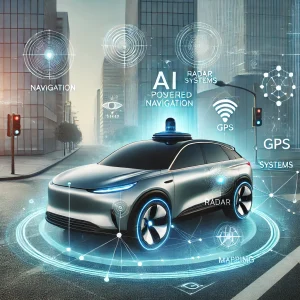The Science Behind Self-Driving Cars: How Do They Work?

The Science Behind Self-Driving Cars: How Do They Work?
Self-driving cars, once a vision of science fiction, are now a reality shaping the future of transportation. These autonomous vehicles leverage advanced technologies to navigate roads, avoid obstacles, and ensure safety—all without human intervention. In this article, we explore the science behind self-driving cars, diving into their core technologies, functions, and potential to revolutionize the way we travel.
—
What Are Self-Driving Cars?
Self-driving cars, also known as autonomous vehicles (AVs), are vehicles capable of operating without direct human input. They rely on a combination of hardware and software systems, including sensors, cameras, artificial intelligence (AI), and advanced algorithms, to interpret their surroundings and make driving decisions.
READ ALSO: Top 10 Gadgets Every Tech Enthusiast Needs in 2024.
—
Levels of Autonomy in Self-Driving Cars
The Society of Automotive Engineers (SAE) defines six levels of vehicle automation, ranging from Level 0 (no automation) to Level 5 (full automation):
1. Level 0: No automation—driver controls everything.
2. Level 1: Driver assistance—features like adaptive cruise control.
3. Level 2: Partial automation—systems like Tesla’s Autopilot.
4. Level 3: Conditional automation—vehicle handles driving under specific conditions.
5. Level 4: High automation—vehicles can operate autonomously in designated areas.
6. Level 5: Full automation—no human intervention required, anywhere.
—
Core Technologies Behind Self-Driving Cars
1. Sensors and Perception
Self-driving cars use a variety of sensors to detect their environment:
LiDAR (Light Detection and Ranging): Measures distances by emitting laser pulses, creating detailed 3D maps.
Radar: Tracks objects’ speed and distance, even in poor weather.
Cameras: Provide visual data for lane detection, traffic signs, and object recognition.
Ultrasonic Sensors: Assist with close-range detection for parking.
2. Artificial Intelligence (AI)
AI acts as the brain of self-driving cars, enabling them to:
Recognize and classify objects (e.g., pedestrians, vehicles).
Predict movements of nearby objects.
Make decisions in real time.
3. Mapping and Localization
Accurate navigation requires precise mapping and positioning:
High-Definition Maps: Provide detailed information about roads, traffic signals, and landmarks.
GPS: Offers global positioning, allowing the vehicle to determine its location.
4. Control Systems
These systems manage the car’s movements by:
Interpreting data from sensors.
Sending commands to control acceleration, braking, and steering.
—
How Do Self-Driving Cars Work?
The operation of self-driving cars can be broken down into three main processes:
1. Perception
Sensors gather data about the car’s surroundings. For example:
Cameras identify lane markings.
Radar detects nearby vehicles.
LiDAR creates a 3D map of the area.
2. Planning
AI algorithms process sensor data to:
Understand the environment.
Plan a safe route.
Predict and respond to potential hazards.
3. Control
The vehicle executes the plan by controlling acceleration, braking, and steering.
—
Benefits of Self-Driving Cars
1. Enhanced Safety
Autonomous vehicles are designed to reduce accidents caused by human error, which accounts for over 90% of road accidents.
2. Increased Efficiency
Features like adaptive speed control and optimized route planning reduce traffic congestion and fuel consumption.
3. Accessibility
Self-driving cars can provide mobility for individuals unable to drive, such as the elderly or disabled.
—
Challenges in Self-Driving Technology
1. Ethical Dilemmas
Autonomous cars must make complex decisions in emergencies, raising ethical questions about prioritizing lives.
2. Regulatory Hurdles
Governments must establish laws to regulate the deployment of self-driving vehicles.
3. Technological Limitations
Adverse weather conditions and incomplete infrastructure can disrupt sensor functionality.
4. Cybersecurity Risks
Autonomous vehicles are vulnerable to hacking, posing risks to passenger safety.
—
The Future of Self-Driving Cars
1. Widespread Adoption
Companies like Tesla, Waymo, and Uber are leading the way in autonomous vehicle technology. By 2030, self-driving cars are expected to dominate the transportation industry.
2. Integration with Smart Cities
Self-driving cars will likely become integral to smart city ecosystems, coordinating with traffic systems and public transportation for seamless mobility.
3. Environmental Impact
Electric self-driving cars can significantly reduce carbon emissions, contributing to greener cities.
—
Conclusion
The science behind self-driving cars represents a remarkable blend of innovation and engineering. By integrating cutting-edge technologies like AI, LiDAR, and advanced mapping, these vehicles are poised to redefine transportation. However, challenges such as ethical dilemmas and regulatory concerns must be addressed to unlock their full potential. As technology evolves, the dream of a fully autonomous future inches closer to reality.





